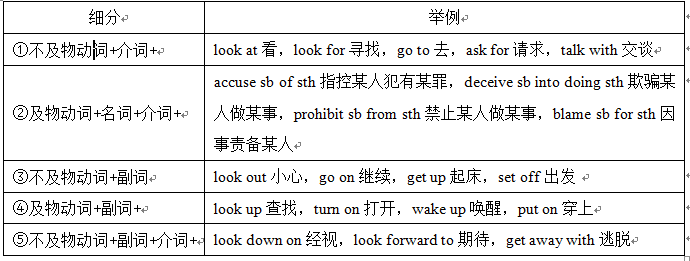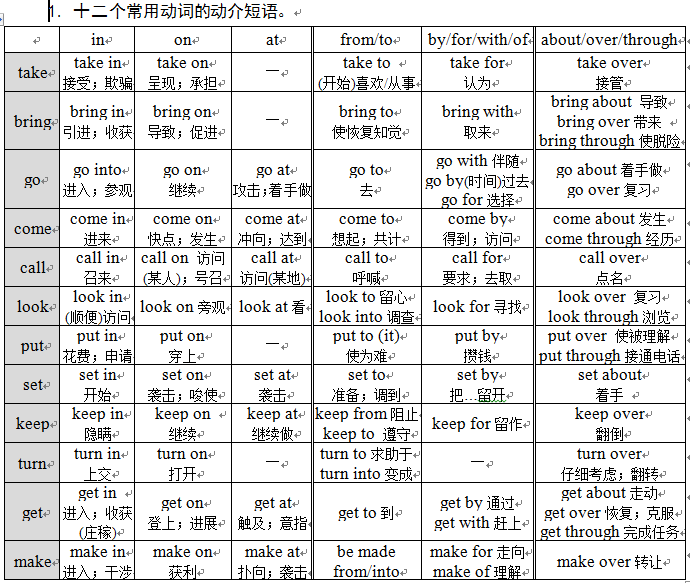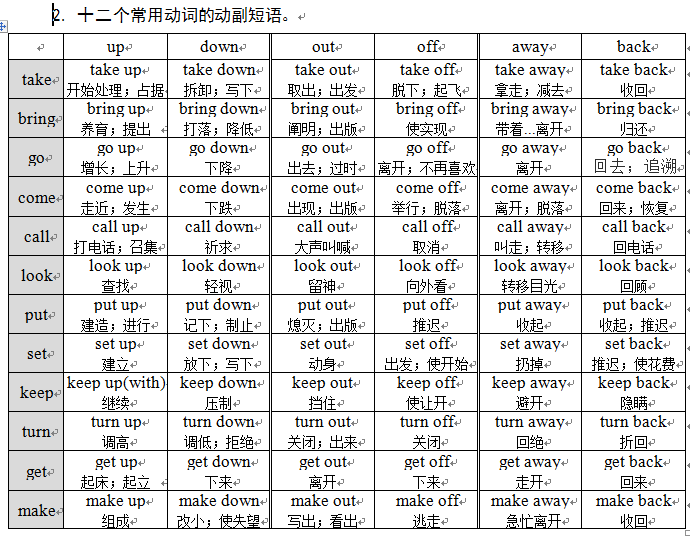一.短语动词概述
短语动词,就是动词与介词/副词组成短语,起动词作用。
1.短语动词的分类。其中,最典型的是动介短语和动副短语。
注意,短语动词,常常构成全新的意义,不是二者意义的简单相加。
2.动介短语的两种分析方法。
动词+介词+宾语,可以分析为:短语动词(动词+介词)+宾语,也可以分析为:动词+介词短语(介词+宾语)。两种方法都对,各有各的用途。如,
●look at sth,可以分析为:look at (短语动词)+sth,也可以分析为:look (不及物动词)+ at sth。第②种分析,提示我们,要么单用look,要加就直接加介词短语at sth。
●instead of sth,可以分析为:instead of (短语介词)+sth,也可以分析为:instead (副词)+ of sth(介词短语)。第②种分析,提示我们,要么单用instead,要加就直接加介词短语of sth。
3. 动介短语与动副短语的区别
①及物性不同。因为,动介短语=vi.+介词,介词必须加宾语,所以必须加宾语。因为,动副短语=vt./vi.+副词,副词与及物性无关,所以按照vt./vi.而决定加/不加宾语。如,get up,look out(动副短语,不及物)。put on your coat,hand in your exercises(动副短语,及物)。
②宾语位置不同。动介短语所加宾语必须放在介词后;如,Listen to the radio. Listen to it.(不能说Listen it to.)。动副短语所加宾语,如果是名词则放在副词前或后,如果是代词则必须放在副词之前。如,Turn on the light. Turn the light on. Turn it on.(不能说Turn on it.)
二. 常用动词的动介短语和动副短语
在第一章第五节,我们已经讲过“十二个常用动词”。现在讲它们组成的动介短语和动副短语。
(注:1.在上表中,主要是动介短语,有个别是动副短语(如此表中的on主要作副词)。为了制表方便(如,in/on/at放在一起),就把它们放在一起了。第1—5列是九个最常用介词,第6列是其它介词。2.在下表中,主要是动副短语,有个别是动介短语。3.在上表和下表中,in/on/about/over/through等词,有时是介词,有时是副词。4.在这两个表中,from/to, up/down, in/out, on/off等是反义词。5.在这两个表中,有许多短语并非高中需要掌握的内容。)
分组对比练习:
题组(look ~)
1. I often the words I don’t know in the dictionary or on the Internet. (2011,四川)
A.look up B. look at C. look for D. look into
句意:我经常在字典里或网上查找我所不懂的单词。选A。
2. Terry, please your cell phone when Grandma is talking to you. (2014,安徽)
A. look up from B. look into C. look back on D. look through
句意:特里,当奶奶和你说话的时候,从手机上抬起头来。分析:look up 查找,抬头看;look into调查/研究;look back on回顾/回忆;look through仔细检查,看穿;选A。
3. Before you pay a visit to a place of interest, look in your local library a book about it. (2013·安徽) A.on B.at C.for D.to
句意:在你到某个旅游胜地参观之前,先在你们当地的图书馆找一本与之相关的书看看。
分析:后半句的本来语序是look for a book about it in your local library。把地点状语in your local library提前了,增加了试题的难度。选C。
题组(put ~)
1. My mother opened the drawer to _ the knives and spoons. (2010,全国II).
A. put away B. put up C. put on D. put together 选A。
2. At the last moment, Tom decided toa new character to make the story seem more likely.(2013,全国Ⅰ) A.put up B.put in C.put on D.put off
句意:为了使故事看起来更加具有可能性,汤姆决定加入一个新角色。选B
3. Mary is really good at taking notes in class. She canalmost every word her teacher says.(2012,全国Ⅰ) A. put out B. put down C. put away D. put together 选B。
句意:玛丽很擅长在课上记笔记。她几乎能记下老师说的每一个字。
分析:put out扑灭,put down记下,put away放到一边,put together组合。选B。
题组(set ~)
1. We to paint the whole house but finished only the front part that day. (2012,全国II).
A. set about B. set up C. set out D. set down
句意:那天我们开始粉刷整个房子,但只完成了前面的部分。
分析:set about开始做(后接名词/动名词),set up建立,set out开始做(后接不定式),set down写下、记下。根据to paint可知选set out。因此选C。
2. In much of the animal world, night is the time for sleep—pure and simple.(2013,湖北) A.set aside B.set down C.set off D.set up
句意:对于大多数动物而言,夜晚就是被腾出来睡觉的时间—纯粹而简单。分析:set aside留出…用于。选A。
题组(turn ~)
1. Thousands of people to watch yesterday’s match against Ireland. (2010,辽宁)
A. turned on B. turned in C. turned around D. turned out
句意:数千人出来观看了昨天同爱尔兰队的比赛。选D。
2. How could you such a fantastic job when you have been out of work for months. (2014浙江) A. turn off B. turn in C. turn down D. turn to
句意:你已经失业了好几个月了,你怎么能够拒绝如此好的一份工作呢?选C。
题组(~ over)
1. To get a better grade, you should the notes again before the test. (2011,四川)
A. go over B. get over C. turn over D. take over
句意:为了获得好成绩,你应该在考试前好好复习这些笔记。选A。
2. Team leaders must ensure that all members their natural desire to avoid the embarrassment associated with making mistakes.(2013,江苏) A.get over B.look over C.take over D.come over
句意:团队领导者必须确保所有队员克服本能的欲望以规避犯错误带来的风险。 分析:get over克服,look over从上面看过去,take over接管,come over过来,(情绪)占据。选A
题组(~ up)
1. Jenny was looking for a seat when, luckily, a manand left. (2010,四川).
A. took up B. got up C. shut up D. set up
句意:珍妮正在找一个座位,很幸运地,正在那时一个人站起来离开了。选B。
2. Sam __ some knowledge of the computer just by watching others working on it.(2010,山东) A. brought up B. looked up C. picked up D. set up
句意:山姆只是通过看别人操作电脑便学到了一些电脑知识。分析:pick up好转,开车接人,认出,学会。选C。


